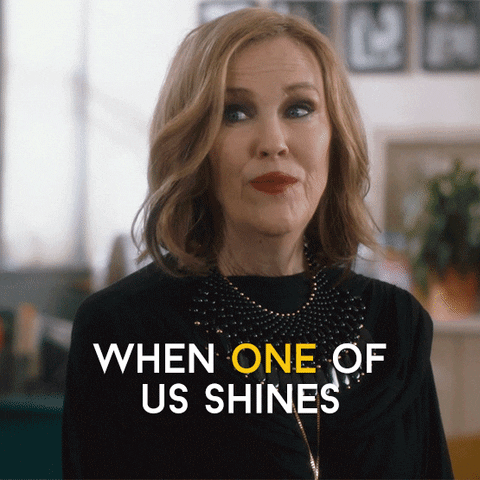To assume positive intent means to choose to believe the best of people and trust that they have good intentions.
This isn’t just a vague “good vibes only” mantra that shies away from actual challenges. It’s a psychologically-backed tactic — the simple act of assuming positive intent leads to happier and more effective teams. We’ve seen it firsthand here at Uptick, but we also talked to Kate Rosenblatt, MA, LPC, LMHC, and provider operations manager at Talkspace, to get her expert insights.
Here’s what happens when you assume positive intent in the workplace and how you can approach every conversation with this mindset.
Team Members View Situations in a More Positive Light
How you frame things matters. When things are framed in a positive light, the human mind leans into that framing. When you assume positive intent during conversations with team members, it primes them to approach the conversation with a positive outlook as well. Think of the classic glass half-full versus half-empty example. It’s always the same glass, but the first description focuses on the gains while the latter focuses on the losses.
You can use this same tactic with the people you manage. Whatever you want to discuss with a team member, frame the conversation in a way that shows you assume positive intent. Let’s say you have a one-on-one with an employee who has missed several deadlines. Look at the stark difference between these openers:
Option 1: Hey Joe, let’s talk about your workload. How can I help? What can we do together to re-prioritize?
Option 2: Hey Joe, what’s going on with all these missed deadlines? Why can’t you keep up?
While both options share the same goal — to figure out why Joe is missing deadlines and get him back on track — option 1 assumes positive intent and shows Joe that this is a supportive discussion, which will make him more open to talking. Option 2 clearly uses negative framing and will likely make Joe feel criticized and defensive.
One study tested how framing influences mindsets by splitting people into two groups and describing a surgery as either having a 70% success rate (positive framing) or a 30% failure rate (negative framing). Unsurprisingly, when the surgery was presented in a positive light, the participants were supportive of the procedure. But when the same surgery was described in relation to a failure rate, people did not like it. It’s the same data — the reactions all boiled down to how it was framed.

Rosenblatt explains why a positive intent mindset is so powerful, “What we think impacts how we feel, which impacts what we do,” says Rosenblatt, “…by assuming the best in people, you might discover new information about this person and their intentions, and perhaps even collaboratively align on solutions to resolve this issue and prevent it from happening again.”
Work Cultures Are Healthier and More Productive
When you assume positive intent, it gives your team a sense of psychological safety, which creates a healthier and more productive work culture. If you lead with negative intent or assume an employee means to do harm, you create a culture in which employees are more apt to blame each other or their managers for issues and challenges.
“Assuming positive intent with colleagues can have a positive effect on relationships at work,” says Rosenblatt. “I have seen this lead to enhanced trust, and increased productivity.” And it’s not just one person’s observation — studies show that happy employees are more productive.

Going into conversations with a positive outlook prevents costly turnover as well. According to the Work Institutes 2020 Retention Report, employees who quit due to manager behavior cite reasons such as employee treatment, fairness, and communication. No one wants to work for a manager who is always suspicious of their intentions.
Imagine you have a team member who has been turning off their camera during meetings and not participating in discussions as much as they did before. Consider these different ways of broaching the subject:
Option 1: Hey Tomás, you haven’t been very involved in discussions lately, and you haven’t turned your video on in a couple of weeks. I expect team members to actively engage during meetings, not multitask. Make sure you are focusing on the meetings and contributing to the conversation.
Option 2: Hey Tomás, I’ve noticed you haven’t been using your video or engaging in conversations during meetings recently. I miss seeing your face and hearing your insights. I’m sure there are plenty of things going on at work and at home. Is there anything I can do to help you feel more comfortable jumping in on discussions?
Option 1 comes off as a reprimand and presumes that Tomás is slacking off during meetings. Option 2, on the other hand, assumes positive intent and shows Tomás you are there to support him.
You can use this formula to address any issue while still assuming positive intent.
- State the problem in a neutral, non-accusatory way.
- Ask questions that encourage the team member to talk openly.
- Be clear that you want to work together to find a solution.
Remember — to assume positive intent means to believe the best of people. If you ever feel yourself jumping to conclusions about someone’s intentions, remind yourself that your team can’t do their best work if management is constantly doubting their abilities.
Want to be a better manager with a happier, healthier and more effective team?
Sign up for a free coaching consultation with Uptick Co-founder Chris Zaugg to improve your team’s effectiveness by connecting relationally.
Managers Can Help Identify and Address Challenges
Assuming positive intent is solution-based instead of problem-centric. If you believe people want to do their best work, you’re better prepared to help them accomplish that by looking for solutions together.
We’ve talked before about replacing blame with curiosity — asking your team member why something isn’t working instead of assuming you already know. If you go into a conversation with a team member thinking you already know what’s wrong, you put all the focus on the problem. However, if you assume positive intent, you steer away from the negative filter (this person isn’t doing their job) and focus instead on what is preventing them from doing a good job.
This is one of the many reasons we stress that one-on-ones are for high-value conversations, not status updates. If you’re only meeting with your team members on a weekly basis so each employee can recite what they did and did not get done, you’re wasting everyone’s time — those things can be done in an email or chat. Every one-on-one should deepen your relationship with your team member — what better way to build trust than to show your team you have faith in them and want to actively support them?
Let’s say you expected the new website design to launch on Monday, and it didn’t happen. Take a look at these two ways you could go into a one-on-one with your head developer.
Option 1: Hey Rayna, what’s going on with the new design launch? We’re 3 days past the target date. What are you working on today?
Option 2: Hey Rayna, how’s your month been going? What would be most helpful to discuss today?
Option 1 comes off as suspicious or even accusatory. Chances are, she knows she missed a deadline. Instead of reminding her about it, try something like option 2 — ask her how things are going and be prepared to listen attentively. You never know everything that’s happening in someone’s life at home or even at work. Give them a chance to share, so you can identify roadblocks and figure out how to remove them.
Choose to Assume Positive Intent
You can’t build strong teams if you don’t trust that your team members are doing their best. Think of it this way — what if every time a student failed a test, the teacher assumed the student simply didn’t want to pass? Do you think the student would feel motivated to practice and improve? Would they take further direction from the teacher? Probably not.
“I would argue that it often just feels better to simply see people as doing the best they can,” says Rosenblatt. “Why go through life choosing to give everyone a C (assume negative intent) and let their behavior determine their grade in our book, when we can just as well start by giving everyone an A (assume positive intent) and go from there?“
You have nothing to gain by assuming the worst of people. If you want an effective team, start by believing that everyone else wants that, too.
Ready to work on assuming positive intent in your one-on-ones? Try our Decks feature to use curated collections of questions that make having great conversations with your team members as simple as shuffling a (virtual) deck.
Want to be a better manager with a happier, healthier and more effective team?
Sign up for a free coaching consultation with Uptick Co-founder Chris Zaugg to improve your team’s effectiveness by connecting relationally.


